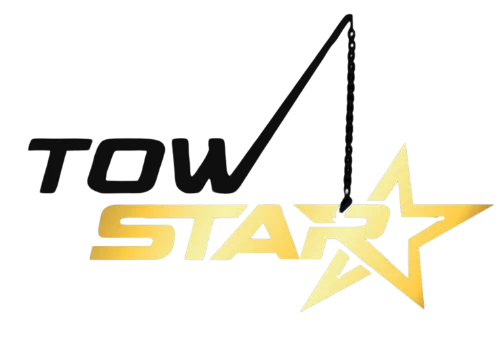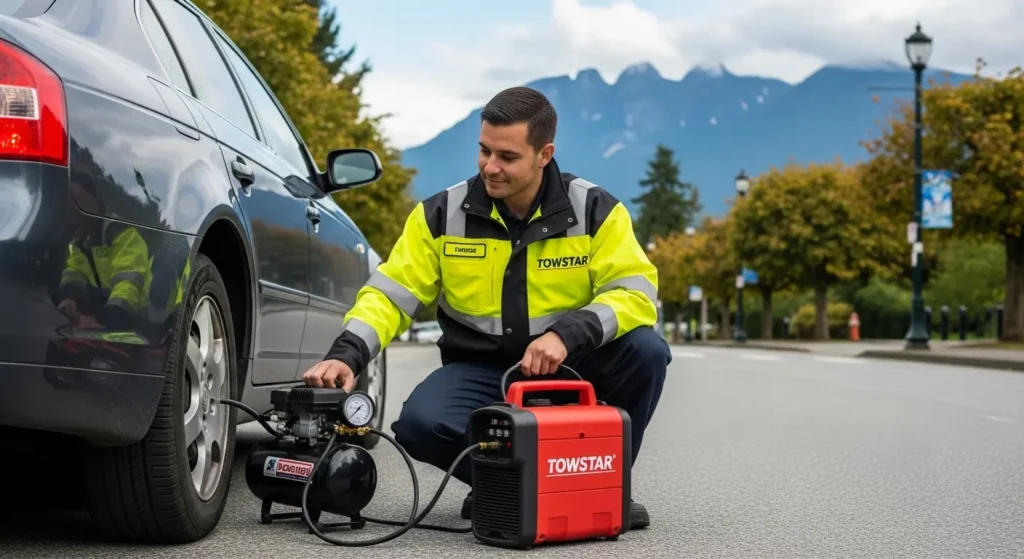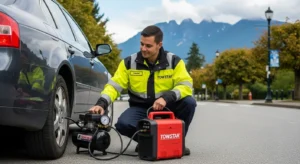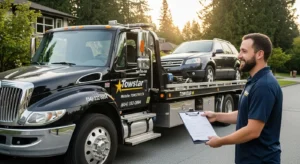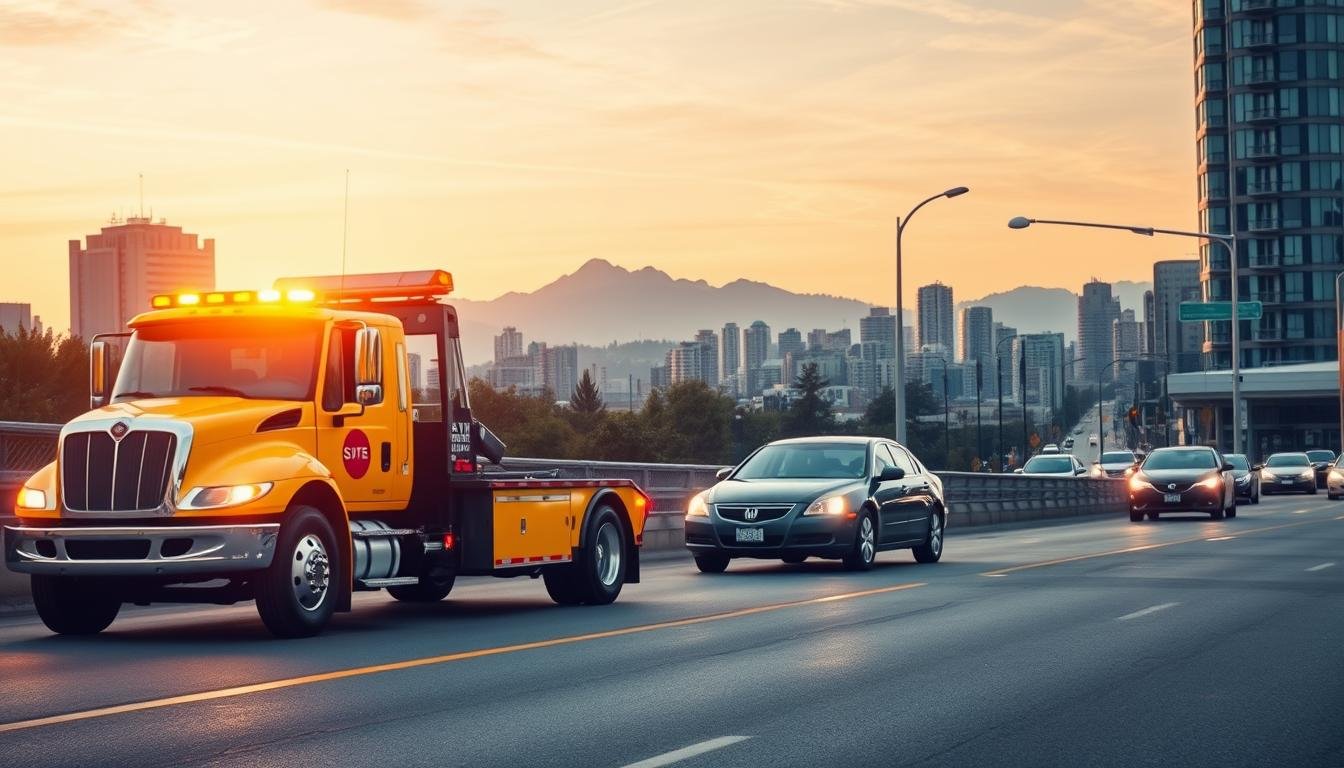You’re sitting in your car researching roadside assistance options because you know you should have a plan before you need one. Smart move. But now you’re overwhelmed with choices. CAA? Insurance add-on? Mobile service? Local company? Each one says they’re the best. Each one has different pricing, different coverage limits, different service areas. You don’t know what actually matters and what’s just marketing noise.
You need to know what questions to ask. You need to know what red flags mean “skip this company.” You need to know the difference between what sounds good and what actually works when you’re stressed and stranded.
Here’s what we know about your situation:
- Make the right choice now instead of discovering you picked wrong when you’re already in crisis
- Let’s talk about roadside assistance cost but also response time, coverage, and professionalism
How to Actually Evaluate Your Options
Choosing a roadside assistance provider isn’t like picking a restaurant where you can just try somewhere new next time. You’re making a commitment for a year, and you’ll only really know if you picked the right one when you’re already stranded. So let’s talk about what actually matters when you’re evaluating your options.
If you’re new to this whole thing, start with our complete guide to understand what roadside assistance is. This article focuses on helping you choose between your options. We’ve also put together a detailed cost breakdown so you understand the financial side of each choice.
Need to book right now? Give us a call at (236) 245-1552 — we’re available 24/7. We’ll answer your questions about coverage and pricing with zero pressure.
The First Question: What’s Your Response Time Priority?
This is the single most important factor, and it’s the one most people overlook when they’re just looking at annual price.
When your car breaks down, you’re stressed. Time feels like it’s moving in slow motion. A 45-minute wait feels like two hours. A two-hour wait feels like a nightmare. So response time should be your first evaluation metric, not your last.
Here’s what to ask:
- What’s the average response time for my area of Burnaby? Don’t accept vague answers like “as soon as possible.” Ask for a specific number. 20 minutes? 45 minutes? 2 hours? Different providers have vastly different service areas and positioning.
- Does response time change based on location? If you break down near Brentwood, is it faster than if you break down in a remote part of Burnaby? This matters.
- What time of day do I call? Do they operate 24/7, or do they have restricted hours? If you break down at 2 AM, can they actually help?
- Can I track where the truck is? Some providers let you see real-time location. Some just say “someone will call you 15 minutes before we arrive.” Which matters more to you?
Response time is the difference between “this is managable” and “this is a disaster.” Don’t ignore it just because you’re focused on price.
The Second Question: What’s Actually Covered?
This is where the fine print gets you. Two services can have the same price and completely different coverage because of what they exclude.
According to IAM Member Resources’ breakdown of roadside assistance basics, key factors to consider include coverage alignment with your needs, cost versus budget, provider network coverage in your area, and 24/7 dispatch availability. You need to read the coverage details closely—including caps on the number of times per year you can use the service, covered towing distances, and whether fuel and replacement parts are free or not.
For a detailed breakdown of what roadside assistance in BC really covers, it’s important to understand exactly which services are included in your plan so you’re not surprised when you actually need help.
Here’s what to ask:
- How many service calls per year do I get? Is it unlimited, or does it stop at 4 per year? What happens if I exceed that limit?
- What’s the towing distance covered? Some services cover 5 miles free, then charge per mile. Some cover 50 miles. Some cover unlimited distance. This dramatically changes the value.
- Do you cover the cost of fuel and parts? This is crucial. Some memberships cover the labor to jump-start your battery but not the replacement battery itself. Some cover fuel delivery but not the fuel. Read carefully.
- Are there specific scenarios where you won’t help? Some don’t cover you if you’re towing equipment or if you’re towing a motorcycle or RV. Know your vehicle and know the coverage.
- What happens if I use the service outside my membership area? If you drive to Vancouver and break down there, are you covered? Partially? At extra cost?
The cheapest membership isn’t the best value if it doesn’t cover what you actually need.
The Third Question: Is the Pricing Transparent?
You’ve probably noticed that “lowest price” and “best value” are two different things. But you also don’t want to get surprised by hidden fees.
Here’s what to ask:
- What’s included in the quoted price? If they quote you $150 for a tow, does that include the service fee plus mileage, or is mileage additional? Get clarity.
- When would the price increase? Can they guarantee the quoted price, or might it go up if “complications” arise? Ask for scenarios where the final bill might exceed the quote.
- Are there any membership fees that aren’t obvious? Some services quote an annual fee but don’t mention that you’ll also pay per-call fees after a certain number of calls. Others don’t include extended coverage for specialty vehicles. Know what you’re actually committing to.
- Is there a discount if I pay upfront vs. monthly? Some companies charge more if you pay monthly. Understanding the full-year cost matters.
You don’t want the cheapest; you want the most transparent. A company that clearly explains what you’ll pay is more trustworthy than a company that seems cheap but has hidden limitations.
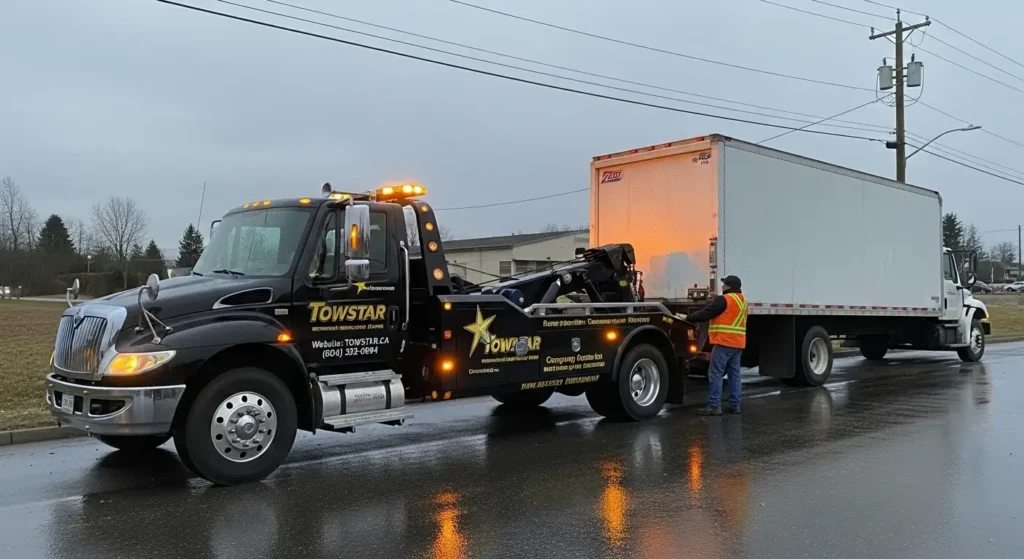

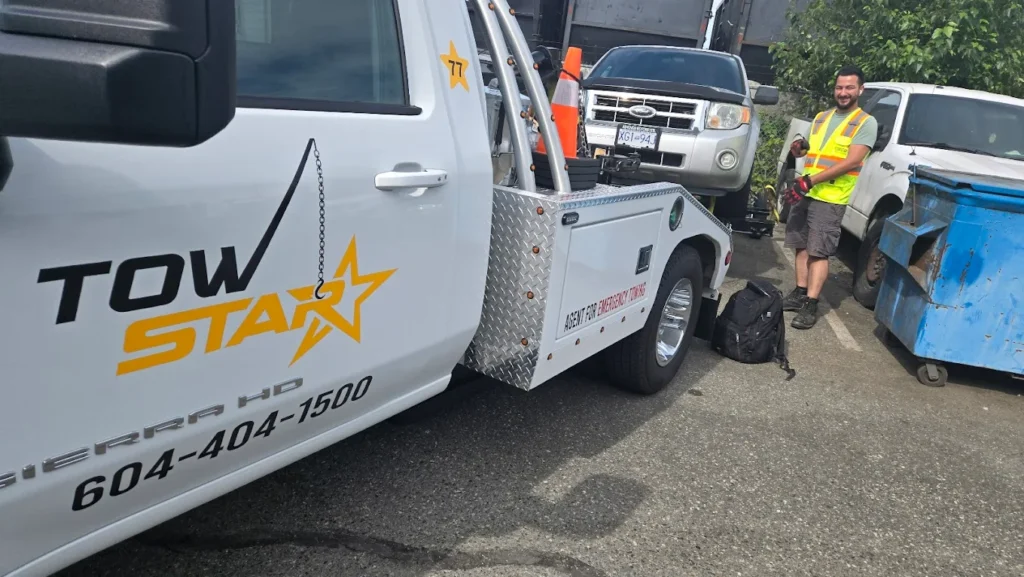
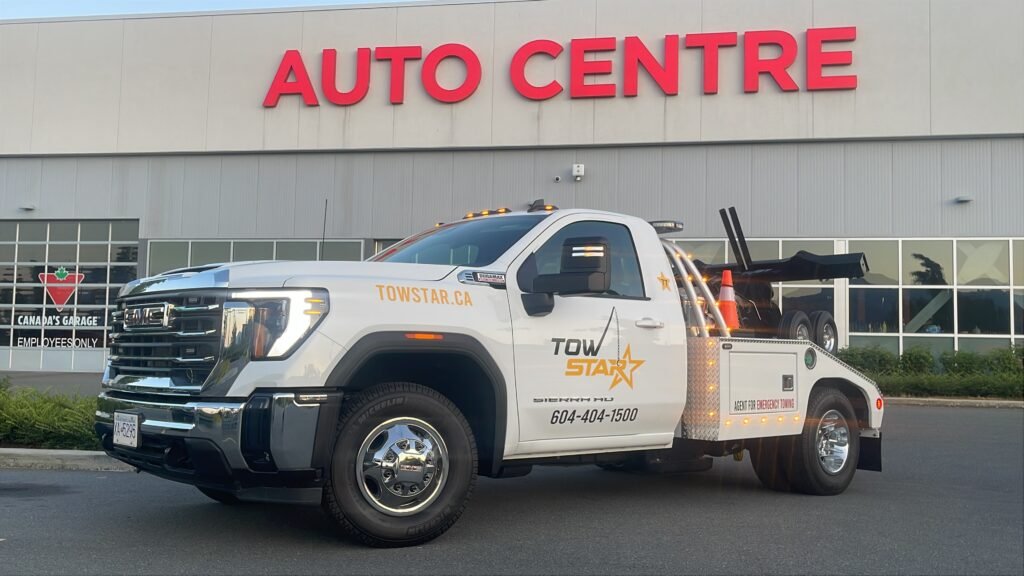
The Fourth Question: Do They Actually Understand Burnaby?
Here’s something that changes everything: Does the company actually know Burnaby, or are they a generic towing service that covers “the Vancouver area”?
Burnaby has specific challenges—underground parking at Metrotown, complex street layouts in Central Park, rush hour chaos on Canada Way, weather challenges in the hills. A company that knows these challenges is fundamentally different from a company that just has a truck somewhere in the lower mainland.
According to the City of Burnaby’s emergency preparedness and community services information, understanding local infrastructure and emergency response capabilities is crucial for residents. Burnaby’s unique geography and traffic patterns require service providers who have on-the-ground knowledge of neighborhoods and specific challenges.
Here’s what to ask:
- Do you have trucks positioned in Burnaby? Or are you dispatching from somewhere else and hoping to reach you fast? Location matters.
- Have you worked in my specific neighborhood? Can they tell you about the unique challenges of Brentwood? Central Park? Metrotown underground? Burnaby Heights?
- Do you understand Burnaby traffic patterns? Can they predict response times based on time of day? Do they know the best routes?
- Have you dealt with underground parking situations? If this is relevant to you, ask if they have experience with low-clearance towing scenarios.
Local knowledge isn’t just convenience—it’s the difference between a 20-minute response and a 2-hour response.
The Fifth Question: What Do Their Reviews Actually Say?
Reviews tell you what really happens when you need help, not what the company’s marketing says happens.
According to DriveSafe Online’s guide to choosing roadside assistance, when evaluating reviews, look for patterns around response time, professionalism, unexpected charges, and whether the service actually resolved the problem. Don’t just pick based on a single great or bad review—look for patterns. One bad review out of 1,000 is normal. Ten bad reviews mentioning the same problem is a pattern to pay attention to.
Here’s what to look for in reviews:
- Do they mention response time? If lots of reviews say “took 2 hours,” that’s telling you something marketing won’t. If reviews say “arrived in 15 minutes,” that’s also telling.
- Do they mention professionalism? Are drivers described as kind and respectful, or rushed and dismissive? You’ll be stressed and vulnerable when they arrive—professionalism matters.
- Do people mention unexpected charges? If multiple reviews say they were surprised by fees, that’s a red flag.
- Do they mention the resolution? Did the service actually solve the problem, or did it just create more problems? Did the company follow through if something went wrong?
- What’s the average rating? 4.8 stars with thousands of reviews is different from 5 stars with 12 reviews. Volume matters.
Look for patterns, not individual outliers. One bad review out of 1,000 is normal. Ten bad reviews mentioning the same problem is a pattern.
The Sixth Question: Can They Handle Your Specific Vehicle?
If you drive a newer EV, a luxury car, a motorcycle, or an RV, your roadside assistance needs are different than someone driving a 2010 Honda Civic.
Here’s what to ask:
- Do you have experience with my vehicle type? Can they tow a Tesla without damaging the battery? Do they have proper equipment for luxury vehicles? Can they handle motorcycles?
- What’s your process if my vehicle is outside your expertise? Are they honest upfront, or will they attempt something and charge you anyway?
- Are there additional costs for specialty vehicles? Some companies charge 10-15% more for EVs or luxury cars. That’s fine as long as they tell you upfront.
- Do you ask about vehicle details before dispatching? Good companies ask about your vehicle before they send a truck, so they bring the right equipment. Bad companies dispatch first and figure it out when they arrive.
Know your vehicle’s requirements and make sure any provider you choose can actually handle it.
The Seventh Question: What Happens When Something Goes Wrong?
You want to know not just that they provide service, but how they handle it when something doesn’t go according to plan.
Here’s what to ask:
- What’s your policy if the service doesn’t work? If they jump-start your car and it dies again 10 miles down the road, do they come back? Or is that a second charge?
- What if they damage my vehicle? Do they have insurance for that? What’s the process if damage occurs?
- How do you handle complaints? If I’m unhappy with the service, who do I contact? What happens next?
- Do you guarantee your work? Or am I on my own once they leave?
These aren’t questions most people ask, but they matter enormously if something actually goes wrong.
How to Make Your Final Decision: The Comparison Framework
Now that you know what to ask, let’s put it in a framework so you can actually compare your options.
According to CheapInsurance.com’s comparison of roadside assistance services, when comparing plans you should evaluate the plan offerings and benefits, policy limitations and pricing, membership and coverage extensions, and customer service availability. Some plans offer additional benefits like trip interruption coverage, rental car reimbursement, and discounts that can be deciding factors.
Create a simple chart with these columns:
FactorWeightOption AOption BOption CResponse TimeHigh20 min45 min2 hoursAnnual CostMedium$75$125$0 (insurance add-on)Coverage Per YearHighUnlimited4 calls1 callTowing DistanceHigh100 km10 km5 kmLocal KnowledgeHighYesNoNoReview RatingMedium4.8/53.9/54.2/524/7 AvailableHighYesNoYesVehicle Type ExpertiseMediumYesPartialNo
Fill this in for each provider you’re considering. Weight the factors by importance to you. Response time and coverage limits should be weighted higher than price alone.
Red Flags: When to Skip a Provider Entirely
There are some warning signs that should make you eliminate an option immediately.
- Vague about response time. If they won’t give you a specific number, they don’t have one. Skip.
- Won’t explain coverage limits clearly. If they’re evasive about what’s covered, there’s a reason. Skip.
- Multiple reviews mentioning hidden fees. Pattern behavior suggests it’s real. Skip.
- Can’t handle your vehicle type. If you drive an EV and they say “we can probably figure it out,” that’s not good enough. Skip.
- No 24/7 availability. If you can only call during business hours, and you break down at 11 PM, you’re stuck. Skip.
- Primarily operates elsewhere. If the company is based three hours away, response time will be slow. Skip.
You don’t need to settle for a provider that has major red flags. There are good options available. Hold out for one that doesn’t have obvious problems.
Understanding the top signs you need roadside assistance can help you recognize when a provider is falling short of your needs too.
Why Choose Us for Roadside Assistance in Burnaby
Fast, Local Response Time
We’re positioned across Burnaby specifically so we can reach you in 15–20 minutes. We’re not dispatching from Surrey or Coquitlam and hoping we make good time. We’re already close. That speed isn’t marketing—it’s the result of years of understanding Burnaby’s layout and positioning our team accordingly.
Transparent Pricing, No Surprises
When you call or book with us, you get a clear quote upfront. Not estimated. Not “it might be more.” Clear. That quote is what you pay unless something genuinely changes mid-service—and we tell you about that before we proceed. No hidden fees. No “we discovered it’s more complicated” charges.
Local Knowledge That Matters
We’ve worked accross Burnaby’s neighborhoods—Brentwood, Metrotown, Central Park, Burnaby Heights, everywhere in between. We understand the traffic patterns. We know which streets get congested at which times. We know how to handle underground parking situations that generic towing companies struggle with. That local expertise means faster, better service.
Reviews That Prove It
Check our Google reviews and you’ll see patterns: fast response, professional service, fair pricing, kind drivers. People who were stressed and stranded felt taken care of. That’s not luck—that’s consistency.
Professional Drivers Who Actually Understand Your Situation
Our drivers are trained to handle people who are already stressed. We don’t condescend. We don’t rush. We explain things clearly and treat you with respect. We ask about your vehicle upfront so we bring the right equipment. We handle all vehicle types—standard cars, EVs, luxury vehicles, trucks, motorcycles. We litterally have the tools and knowledge for whatever situation you’re in.
Bottom Line: How to Choose
Here’s the straight answer: Choose the provider that combines fast response time, transparent pricing, local knowledge, and positive reviews. Don’t just pick based on price. Don’t just pick because you’ve heard of the name. Evaluate them on the factors that actually matter when you’re stranded.
If you’re in Burnaby, we genuinely believe we’re the best choice—not because we’re the cheapest, but because we’re fast, transparent, local, and professional. But regardless of who you choose, don’t pick blindly. Ask the questions in this article. Make an informed decision now instead of discovering you picked wrong when you need help.
You don’t have time for mistakes when you’re already in crisis. Make the right choice today.
Book with us now or give us a call at (236) 245-1552 — we’ll answer any questions you have about coverage, pricing, response time, or anything else. Zero pressure. Just honest conversation about whether we’re the right fit for your needs.
FAQ: Your Questions About Choosing Roadside Assistance Answered
What’s the single most important thing to look for in a roadside assistance provider?
Response time. Hands down. Price matters, but it doesn’t matter if help arrives too late. When you’re stranded, a 20-minute response feels like the difference between managable and disaster. Ask for specific response time numbers, not vague promises. If a company won’t give you a specific number, that’s your answer right there.
Should I get roadside assistance through my insurance company or buy it separately?
Should I get roadside assistance through my insurance company or buy it separately?
Depends. Insurance add-ons are often the cheapest option. According to LendingTree’s roadside assistance plan comparison, most insurance companies offer cheap add-on coverage for basic roadside services, sometimes as low as $5-$25 per year. However, a membership plan like AAA or Better World Club may be a better fit if you don’t mind paying extra for more protection, extended towing distances, or additional perks like travel discounts. Compare the specific coverage, towing distances, and any additional benefits before deciding.
Is local experience really that important, or is a big national provider just as good?
Local experience matters more than you think. A big national provider might have a truck somewhere in the lower mainland. A local company has trucks positioned specifically in your neighborhood. Response times are fundamentally different. Plus, a local company understands Burnaby-specific challenges—underground parking, traffic patterns, neighborhood access issues—that a national company is encountering for the first time. If fast response time is your priority, local matters.
What should I do if I find a provider I like but they don’t have great reviews?
Be cautious. Reviews usually reflect the real experience. If everyone’s saying “took forever to arrive” or “they were rude,” that’s not an outlier—that’s who they are. Bad reviews are more honest than marketing copy. If a provider doesn’t have solid reviews, there’s probably a reason. Look for someone with better track record.
Can I switch roadside assistance providers mid-year if I choose wrong?
Usually yes, but check your contract. Some memberships have cancellation fees if you quit early. Some don’t. If you’re worried about making the wrong choice, ask about cancellation policies upfront. Or find a provider with a trial period so you can see if they actually deliver on their promises before you commit for a full year.
How do I know if a provider covers my specific area of Burnaby?
Ask them directly and get it in writing. Call, text, or email and give them your exact address or intersection. Ask them to confirm response time for your specific location. Some areas might have longer response times than others, and you deserve to know that before you buy. Don’t just assume province-wide coverage means they can reach you equally fast everywhere.
What should I do if I buy roadside assistance and then never need it?
That actually means the service worked—you had peace of mind and didn’t need to use it. But if you’re upset about “wasting money,” look at it differently: you paid for peace of mind. Most people who buy insurance, roadside assistance, or any protective service hope they never use it. That’s the whole point. The service was there if you needed it. That had value.
Should I get a premium membership tier or stick with basic coverage?
Depends on how far you drive. If you take lots of road trips or drive long distances, a premium tier with higher towing limits makes sense. If you mostly commute locally in Burnaby, basic coverage is probably fine. Think about your actual driving patterns. Don’t pay for coverage you won’t use, but don’t go cheap if you’re going to need it.
